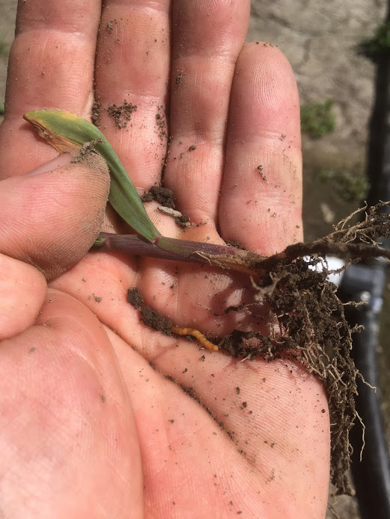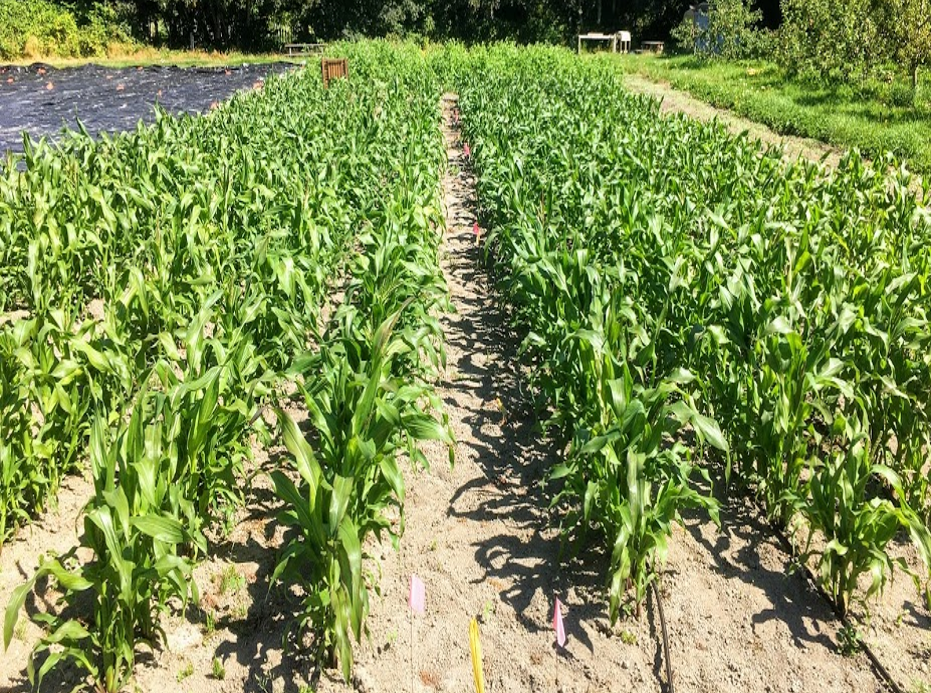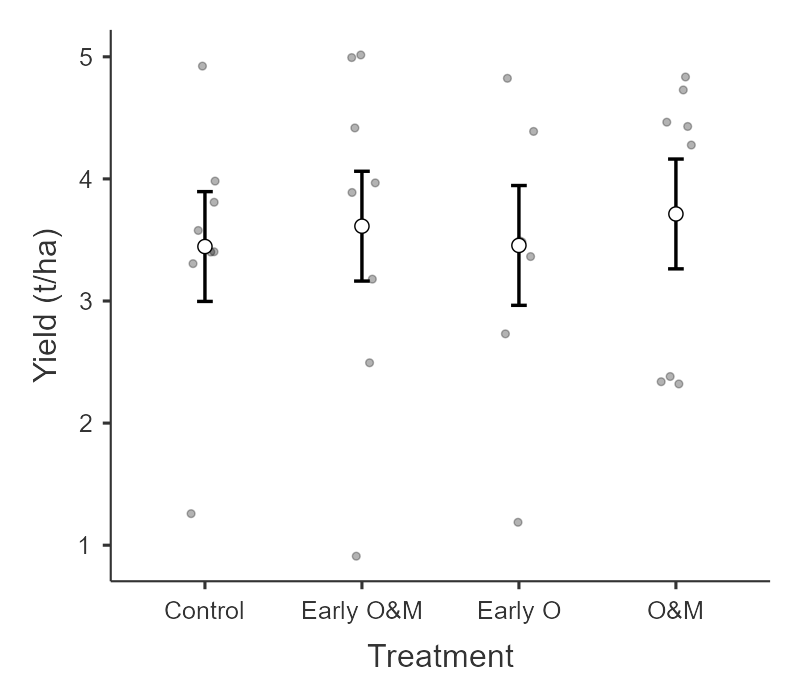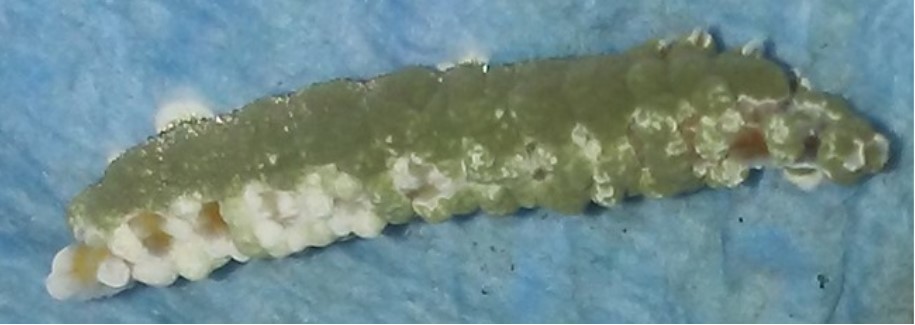

Sustainable Agriculture Student Research Project
Early application of Metarhizium brunneum for management of wireworm in popcorn, Zea mays var. evertaJames Reinert, Department of Sustainable Agriculture and Food Systems, 2020 |
Introduction
Wireworms
- Larvae of various click beetle species (Coleroptera: Elateridae)
- ~800 species worldwide, of which ~30 are serious agricultural pests in Canada
- Agriotes obscurus and A. lineatus are introduced from Eurasia and are the species of primary concern to corn crops in western Canada
- Can live in soil for several years before pupating into adult click beetles
- Attracted to sources of CO2 in the soil, such as the growing roots that they feed on
- Can be distracted from crop roots by other sources of CO2 in the soil from...
- Rolled oats used as bait
- Decomposing soil organic matter (sources may include labile soil carbon, tilled in mulch, cover crops etc.)
Corn - Zea mays (Cyperales: Poaceae)
- Important crop in BC's Fraser Valley, especially in Chilliwack, Agassiz, and Abbotsford
- Highly susceptible to wireworm damage, like other grasses
- Damage to emerging seedlings can be fatal
- Damage to emerging seedlings can be fatal

Wireworm found feeding on popcorn seedling.
Metarhizium brunneum (Hypocreales: Clavicipitaceae)
- Entomopathogenic fungus that has been shown to reduce wireworm damage
- Infective strain isolated from a wireworm cadaver found in Agassiz BC (Kabaluk, Agriculture and Agri-Foods Canada)
- Application timing may influence effectiveness, but has not been well studied in relation to crop planting date
Attract and kill method
-
Rolled oats applied with M. brunneum as a bait CO2 source
Objective
Compare M. brunneum application at popcorn seeding to application four weeks before seeding, in terms of wireworm damage and crop yield.
Methods
Location
- KPU Orchard, Richmond, BC
Experimental design
- Randomized complete block design with eight replicates
- Four treatment plots (2.25 x 2.5 m) per replicate, for a total of 32 plots
- Treatments:
- M. brunneum applied with oats 24 days before seeding
- Oats applied 24 days before seeding
- M. brunneum applied with oats at seeding
- Untreated control
- Treatments:
- Five rows of popcorn (cv. 'Tom Thumb' ) per plot, direct-seeded at 25 cm spacing in-row and 75 cm between rows on July 4
- Rolled oats and M. brunneum banded between crop rows at 10 and 4.2 g/m, respectively, 10-15 cm below soil surface
- Unplanted buffers > 2 m around study site
- Samples collected only from centre row of each plot, excluding 2 plants on either end of this row
- Plant height, plant weight, cob count, seed weight

M. brunneum was weighed (left) and banded between popcorn rows, 10-15 cm below the soil surface (right).

Six week-old popcorn at experimental site.
10 week-old popcorn at experimental site.
Statistical analysis
- Data tested for normality (Shapiro-Wilk)
- ANOVA conducted using jamovi interface for R (α = 0.05 throughout)
Results
No treatment effect was detected on popcorn survival (Fig. 1), plant height (Fig. 2), cob yield (Fig. 3), dry kernel yield (Fig. 4), or any other dependent variable. Some live wireworm samples collected from the study site showed signs of M. brunneum infection in situ (Fig. 5).

Figure 1. Popcorn survival rate by treatment on October 24th, 112 days after planting. Treatments were untreated controls (Control), oats and M. brunneum applied 24 days before seeding (Early O&M), oats applied 24 days before seeding (Early O), or oats and M. brunneum applied at seeding (O&M). Error bars denote standard error of means (n = 8). Grey circles denote values for individual plots.

Figure 2. Popcorn plant height at harvest, by treatment. Treatments were untreated controls (Control), oats and M. brunneum applied 24 days before seeding (Early O&M), oats applied 24 days before seeding (Early O), or oats and M. brunneum applied at seeding (O&M). Error bars denote standard error of means (n = 8). Grey circles denote values for individual plots.
Figure 3. Ears of popcorn per meter of crop row at harvest, by treatment. Treatments were untreated controls (Control), oats and M. brunneum applied 24 days before seeding (Early O&M), oats applied 24 days before seeding (Early O), or oats and M. brunneum applied at seeding (O&M). Error bars denote standard error of means (n = 8). Grey circles denote values for individual plots.

Figure 4. Dry popcorn yield (t/ha) by treatment. Treatments were untreated controls (Control), oats and M. brunneum applied 24 days before seeding (Early O&M), oats applied 24 days before seeding (Early O), or oats and M. brunneum applied at seeding (O&M). Error bars denote standard error of means (n = 8). Grey circles denote values for individual plots.

Figure 5. Wireworm cadaver showing characteristic mycelial growth and sporulation after death due to M. brunneum infection. The specimen was collected live from soil in the experimental area.
Discussion
- M. brunneum was applied at the same site in 2018 and 2019, perhaps contributing to residual activity that masked treatment effects.
- The high organic matter content of the soil may have contributed to CO2 emissions that masked emissions from oats intended to lure wireworms to infective conidia.
Previous attempts to direct-seed corn at the site in 2015, 2017 and 2018 failed due to wireworm-induced seedling mortality. The success of direct seeding in this study may support the hypothesis of residual M. brunneum activity.
Questions for future study:
- Does increased organic matter in soil in organic production systems influence efficacy of M. brunneum as a biocontrol for wireworms?
- Does M. brunneum application in prior growing seasons have residual effects? If so, how long does applied M. brunneum persist in soils?
- Do wireworms respond to M. brunneum conidia when seeking food?

